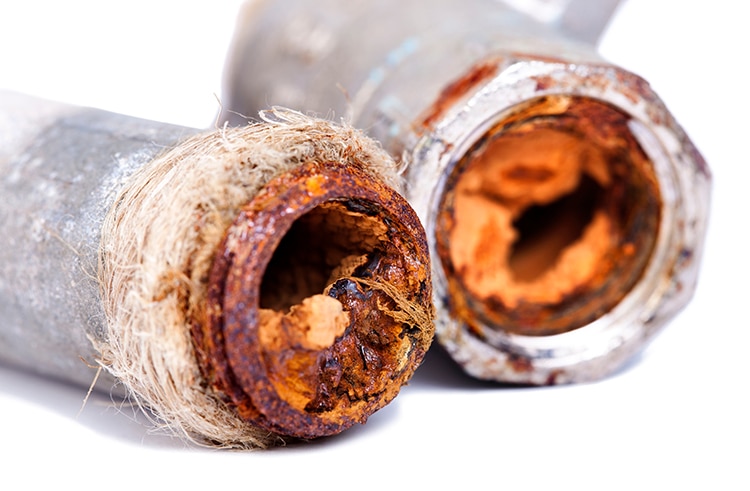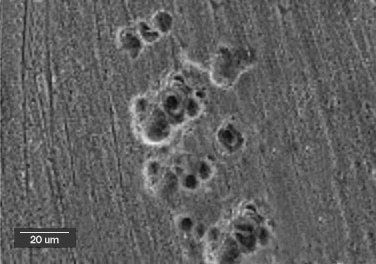
Biocorrosion, also known as microbiologically influenced corrosion (MIC), biological corrosion, or microbial corrosion, is a specific type of corrosion caused or significantly accelerated by the activities of microorganisms on metal surfaces. Unlike traditional corrosion, which is primarily a chemical or electrochemical process, biocorrosion involves complex biological processes that can dramatically alter the rate and pattern of corrosion.
In this in-depth analysis on biocorrosion, we’ll discuss:
- Microorganisms Involved
- Susceptible Components & Assemblies
- Characteristics of Biocorrosion
- Methods to Minimize Biocorrosion
- Mitigation Techniques for Biocorrosion
Microorganisms Involved in Biocorrosion of Metal Components
Several microorganisms involved in biocorrosion, including bacteria and fungi, can adhere to metal surfaces and form biofilms, initiating or enhancing corrosive processes.
Bacteria
Bacteria are the most common culprits in biocorrosion, with several types playing distinct roles:
- Sulfate-Reducing Bacteria (SRB): SRBs (i.e., Desulfovibrio desulphuricans) are among the most notorious for causing biocorrosion. They reduce sulfate to sulfide in anaerobic conditions, which then reacts with the metal to form metal sulfides, leading to pitting corrosion. In extreme cases, SRB can penetrate a ship’s hull.

Corrosion of steel seen at x500 caused by sulfate-reducing bacteria.
- Iron-Oxidizing Bacteria: These bacteria, including Pseudomonadota and Leptothrix spp., oxidize ferrous iron to ferric iron, leading to the formation of iron oxides and contributing to the corrosion process, especially in water systems.
- Iron-Reducing Bacteria (IRB): IRBs, like Shewanella spp., can accelerate corrosion by reducing ferric to ferrous iron under anaerobic conditions, affecting steel structures in particular.
- Acid-Producing Bacteria: Certain bacteria produce acidic by-products like corrosive metabolites, making acid-producing bacteria among the significant causes of corrosion. Spe, Acidithiobacillus ferrooxidans oxidizes sulfide minerals and can generate sulfuric acid, exacerbating corrosion, especially in mining environments.
Fungi
Fungi can contribute to microbial corrosion on concrete by producing organic acids. Species like Fusarium and Aspergillus tamarii have been found on degraded concrete structures, where they can form biofilms and create localized acidic environments, leading to corrosion.
While fungi-induced corrosion is more commonly observed in concrete structures than metal components, it’s been shown to cause more degradation than some acid-producing bacteria. For example, Fusarium has been shown to cause a greater rate of mass reduction in concrete than the damaging bacterial genus Thiobacillus.
Archaea
Archaea, particularly in extreme environments, such as deep-sea vents and oil and gas infrastructure, can cause biocorrosion. Methanococcus maripaludis, a methanogenic archaeon containing hydrogenase, can create highly corrosive biofilms, contributing to metal failure in specific industrial and marine applications.
Algae
Algae contribute to biocorrosion both directly and indirectly, altering their environment by changing pH levels and oxygen concentration, which, along with their metabolites, creates a more aggressive electrolyte for corrosion. Different surface films form on metal surfaces when exposed to natural versus artificial seawater, exacerbated by the uneven spread of algae’s mucilage, promoting corrosion through cathodic depolarization.
Furthermore, algae can foster conditions conducive to the growth of corrosion-enhancing bacteria, such as SRB. These bacteria thrive in the oxygen gradients created by algae, leading to severe forms of corrosion, including the production of hydrogen sulfide gas and ferric sulfide, which cause pitting corrosion and convert sulfates into corrosion sulfide.

Test coupons of unplated grades of stainless steel were compared to 24 hours and 30 days of exposure to a dense population of algae in natural seawater.
Commonly Susceptible Components and Assemblies
Biocorrosion can affect a wide variety of components and assemblies across numerous industries. Some commonly susceptible areas include:
- Pipelines and Storage Tanks: In the oil and gas, water treatment, and maritime industries, pipelines and storage tanks are particularly vulnerable to corrosion. These environments often provide the nutrients and conditions favorable for microbial growth and biofilm formation. Anaerobic sulfate-reducing bacteria are a significant corrosion contributor for in-ground storage tanks.
- Marine Structures: Ships, offshore platforms, and other marine structures face a high risk of corrosion due to the abundant presence of microorganisms in marine environments. Components such as hulls, ballast tanks, and cooling systems are commonly affected. However, modern material science can help reduce the severity of corrosion on ships such as impressed current cathodic protection (ICCP)

Image of ship hull with sacrificial anodes. Sacrificial anodes undergo corrosion to safeguard the hull. As these anodes dissolve, they generate a corrosion current within the system, stemming from the potential difference between the material of the anode and that of the hull.
- Cooling Systems: Industrial cooling systems used in power plants and manufacturing facilities can support the growth of microorganisms if not properly maintained, leading to corrosion of heat exchangers, cooling pipes, and other components.
- Water Treatment Facilities: Components within water treatment and distribution systems, including pipes, valves, and filters, can be susceptible to biocorrosion, especially when biofilms form and protective coatings are compromised.
Biocorrosion Characteristics to Look Out For
Biocorrosion can often be more difficult to detect than other forms of corrosion due to its presence in hard-to-observe areas like underground or submerged pipelines. Microorganisms’ impact on metal corrosion is also multifaceted. The various characteristics below are indicators of potential biocorrosion damage.
- Biofilms: A key characteristic of MIC is the formation of biofilms, which are dense colonies of microorganisms that produce protective and adhesive matrices. These biofilms facilitate the creation of micro-environments that can significantly differ in pH, oxygen concentration, and other factors from the surrounding environment, leading to localized corrosion.
- Localized Corrosion: MIC typically results in localized forms of corrosion, such as pitting, crevice corrosion, or under-deposit corrosion. These localized damage sites can lead to rapid material failure if not detected and mitigated early.
- Diversity of Microorganisms: A wide range of microorganisms can be involved in MIC, each contributing differently to corrosion processes. Some produce acids that directly attack metal surfaces, while others influence corrosion through the production of sulfides or by altering local electrochemical conditions.
- Metabolic Products: The metabolic by-products of microorganisms, such as acids, sulfides, and other compounds, can directly contribute to or accelerate corrosion.
Testing Methods to Minimize Biocorrosion Potential
Testing for microbiologically influenced corrosion is essential for understanding its mechanisms, assessing material performance, and developing effective prevention and control strategies. Some common testing methods and techniques for biocorrosion include:
Electrochemical Techniques
- Ultrasonic Testing (UT): A more common and practical approach to testing for corrosive activity, UT measures the wall thickness in applications like water pipelines to detect corrosion or erosion activity from the inside.

Inspector using ultrasonic instrument to inspect rate of corrosion in petrochemical pipeline.
Visual and Microscopic Examination
- Scanning Electron Microscopy (SEM): SEM, often combined with Energy Dispersive X-ray Spectroscopy (EDS), provides detailed images and chemical analyses of corrosion products and biofilms on metal surfaces.
- Optical Microscopy: This can be used for initial examinations of corrosion patterns and the detection of biofilms on metal surfaces.
Chemical Analysis
- Analysis of Corrosion Products: Techniques such as X-ray diffraction (XRD) and Fourier Transform Infrared Spectroscopy (FTIR) can identify the composition of corrosion products, which may suggest biological activity based on the presence of specific metabolites or byproducts.
Biocide Testing
For industries where biofouling and corrosion are common issues, testing the effectiveness of various biocides in preventing or controlling microbial growth on metal surfaces is essential. The test involves exposing metal samples to different biocides and evaluating the microbial activity and corrosion rate.
These methods can be used individually or in combination to provide a comprehensive understanding of biocorrosion mechanisms, the effectiveness of materials and coatings against corrosion, and the performance of corrosion inhibitors and biocides.
Mitigate Biocorrosion From Your Operations
Mitigating the potential for biocorrosion requires a comprehensive approach. Steps include combining material selection, protective coatings, chemical treatment, and other strategies to control microbial activity and protect metal surfaces. Effective corrosion mitigation enhances the longevity and reliability of infrastructure and equipment. This is particularly useful in industries susceptible to microbial corrosion. Below is a summary of key mitigation strategies:
Material Selection
Choosing inherently corrosion-resistant materials can significantly reduce the risk of biocorrosion-related damage. For example:
- Stainless Steel: Certain grades of stainless steel, especially those with high molybdenum content, offer enhanced resistance to biocorrosion, particularly in environments prone to chloride-induced corrosion.
- Copper Alloys: Copper and its alloys exhibit natural antimicrobial properties. Copper alloys are less susceptible to biofilm formation and subsequent corrosion when cleaned regularly. However, some copper alloys are susceptible to erosion-corrosion at extreme water velocities.
- Duplex and Super Duplex Stainless Steels: These materials combine excellent mechanical properties with high corrosion resistance, making them suitable for challenging environments.
Protective Coatings
Applying protective coatings to metal surfaces can prevent direct contact between the metal and corrosive agents, including microorganisms. Some effective coatings include:
- Nickel-Based Coatings: Nickel coatings can offer both corrosion resistance and antibacterial properties, making them useful in preventing biocorrosion.
- Thin Dense Chrome (TDC): TDC provides a hard, protective surface that resists wear and corrosion, reducing the risk of biocorrosion on components such as hydraulic rods and pump shafts.
- Epoxy Coatings: Epoxy coatings are widely used for their barrier properties, effectively isolating the metal from microbial exposure.
- Antimicrobial Coatings: These specialized coatings include antimicrobial agents capable of inhibiting microbial growth on the surface. Along with copper alloys, most Armoloy thin-dense chrome coatings, such as ME-92 biocompatible thin-dense chrome, are certified antimicrobial.
Chemical Treatment
Chemical treatment strategies aim to control the growth of microorganisms that can cause corrosion:
- Biocides: Regular dosing with biocides can effectively control bacterial populations, including sulfate-reducing bacteria (SRB) and other corrosion-related organisms. It’s essential to rotate biocides to prevent the development of resistant strains.
- Corrosion Inhibitors: These chemicals can be added to fluids in contact with metal surfaces to decrease the corrosion rate. Some inhibitors also have antimicrobial properties.
- pH Adjustment: Adjusting the pH of the environment can make conditions less favorable for microbial growth and biofilm formation.
Environmental Control
Controlling the environment in which metals are exposed can significantly reduce the risk of corrosion:
- Water Treatment: Removing nutrients and oxygen from water systems can limit microbial growth. Filtration and ultraviolet (UV) treatment are common methods used.
- Oxygen Scavengers: Reducing the amount of oxygen in closed systems can help minimize the activity of aerobic microorganisms.
- Temperature Control: Adjusting the environment’s temperature can also impact the rate of microbial growth and biofilm formation.
Monitoring and Maintenance
Regular inspection and maintenance are crucial for early detection and mitigation of corrosion
-
- Inspection and Testing: Inspecting for signs of corrosion and testing for the presence of microorganisms can catch corrosion before significant damage occurs.
- Cleaning and Mechanical Removal: Regular cleaning and removal of biofilms from surfaces can prevent the establishment of conditions favorable for corrosion.
Implementing a combination of these strategies can significantly reduce the risk of biocorrosion, ensuring the longevity and reliability of metal components in various industrial and natural environments. Tailoring the approach to the specific environmental conditions and microbial challenges is essential for effective corrosion mitigation.
Engineered Solutions Targeting Biocorrosion Challenges
Improve durability, minimize maintenance expenses, and enhance operational efficiency in the face of biocorrosion. Armoloy offers a comprehensive suite of meticulously designed plating technologies for applications prone to biocorrosion across various environments. Embrace proactive strategies today to combat the unique challenges posed by biocorrosion.
Share on LinkedIn Share on Facebook
